Managerial Accounting Report: TDABC Evaluation for Austal Ltd. (2024)
VerifiedAdded on 2020/05/16
|12
|2811
|61
Report
AI Summary
This report provides a comprehensive analysis of Time-Driven Activity-Based Costing (TDABC) within the context of managerial accounting. It begins with an introduction to cost accounting and its significance, followed by a description of a client company, Austal Ltd., a ship manufacturer. The core of the report focuses on TDABC, detailing its description, features, and differences compared to traditional Activity-Based Costing (ABC) and traditional costing methods. The report explores the suitability of TDABC for implementation, highlighting its benefits in terms of cost management, decision-making, and operational efficiency. The report also touches upon the key features of TDABC, such as the efficiency and ease of allocation of cost, integration with ERP systems, and the ability to forecast demands effectively. Finally, the report concludes that TDABC is a suitable approach for Austal Ltd., offering insights into cost structures and enhancing the overall production process.
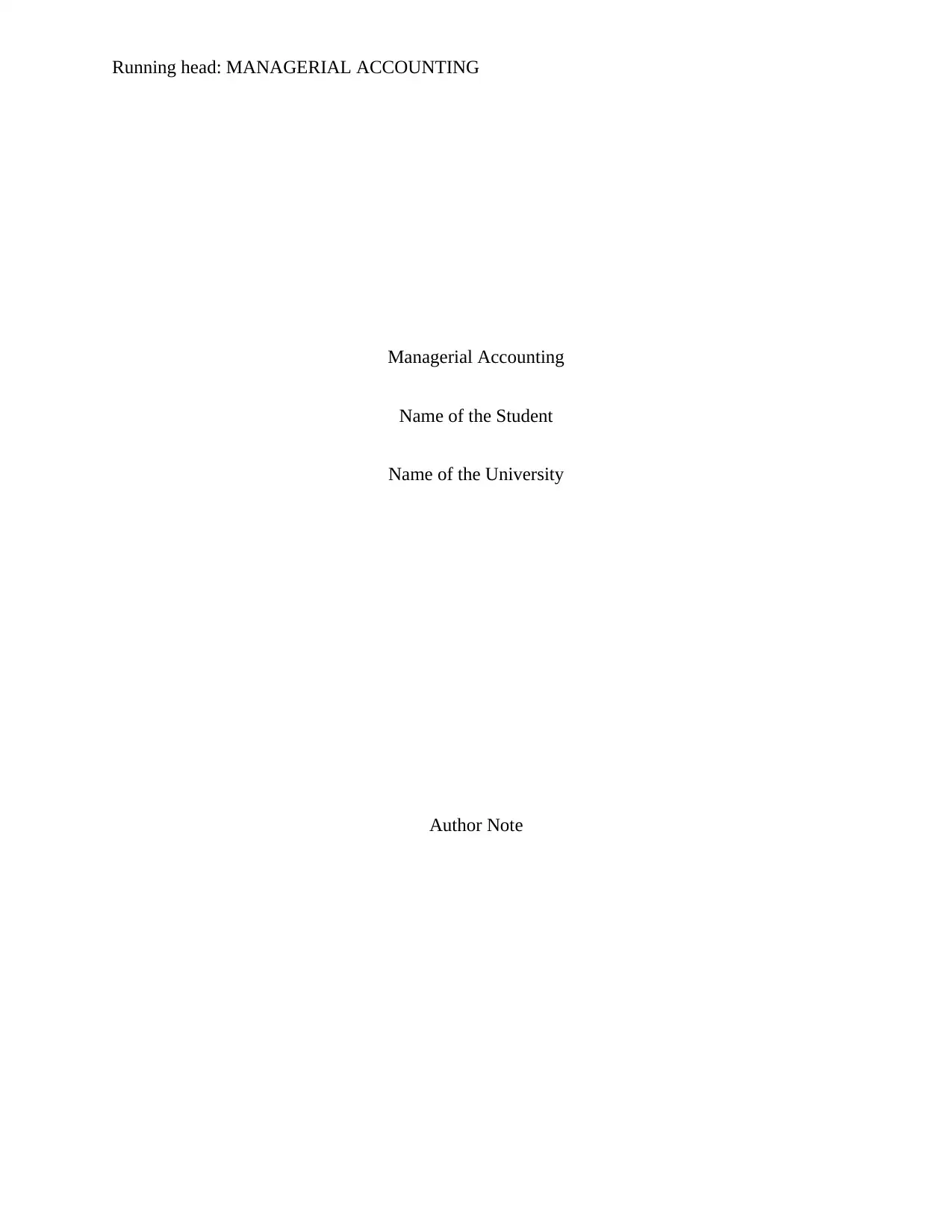
Running head: MANAGERIAL ACCOUNTING
Managerial Accounting
Name of the Student
Name of the University
Author Note
Managerial Accounting
Name of the Student
Name of the University
Author Note
Paraphrase This Document
Need a fresh take? Get an instant paraphrase of this document with our AI Paraphraser
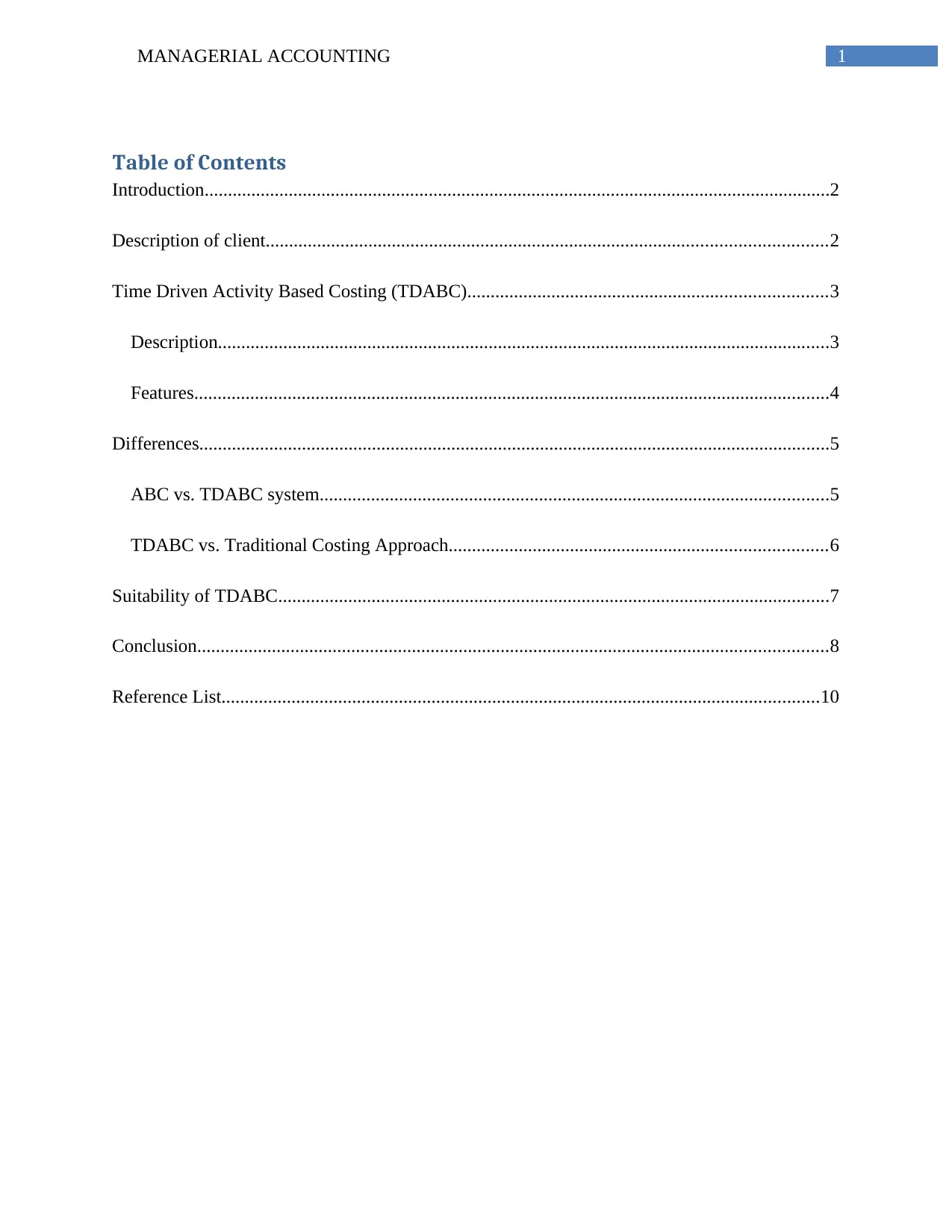
1MANAGERIAL ACCOUNTING
Table of Contents
Introduction......................................................................................................................................2
Description of client........................................................................................................................2
Time Driven Activity Based Costing (TDABC).............................................................................3
Description...................................................................................................................................3
Features........................................................................................................................................4
Differences.......................................................................................................................................5
ABC vs. TDABC system.............................................................................................................5
TDABC vs. Traditional Costing Approach.................................................................................6
Suitability of TDABC......................................................................................................................7
Conclusion.......................................................................................................................................8
Reference List................................................................................................................................10
Table of Contents
Introduction......................................................................................................................................2
Description of client........................................................................................................................2
Time Driven Activity Based Costing (TDABC).............................................................................3
Description...................................................................................................................................3
Features........................................................................................................................................4
Differences.......................................................................................................................................5
ABC vs. TDABC system.............................................................................................................5
TDABC vs. Traditional Costing Approach.................................................................................6
Suitability of TDABC......................................................................................................................7
Conclusion.......................................................................................................................................8
Reference List................................................................................................................................10
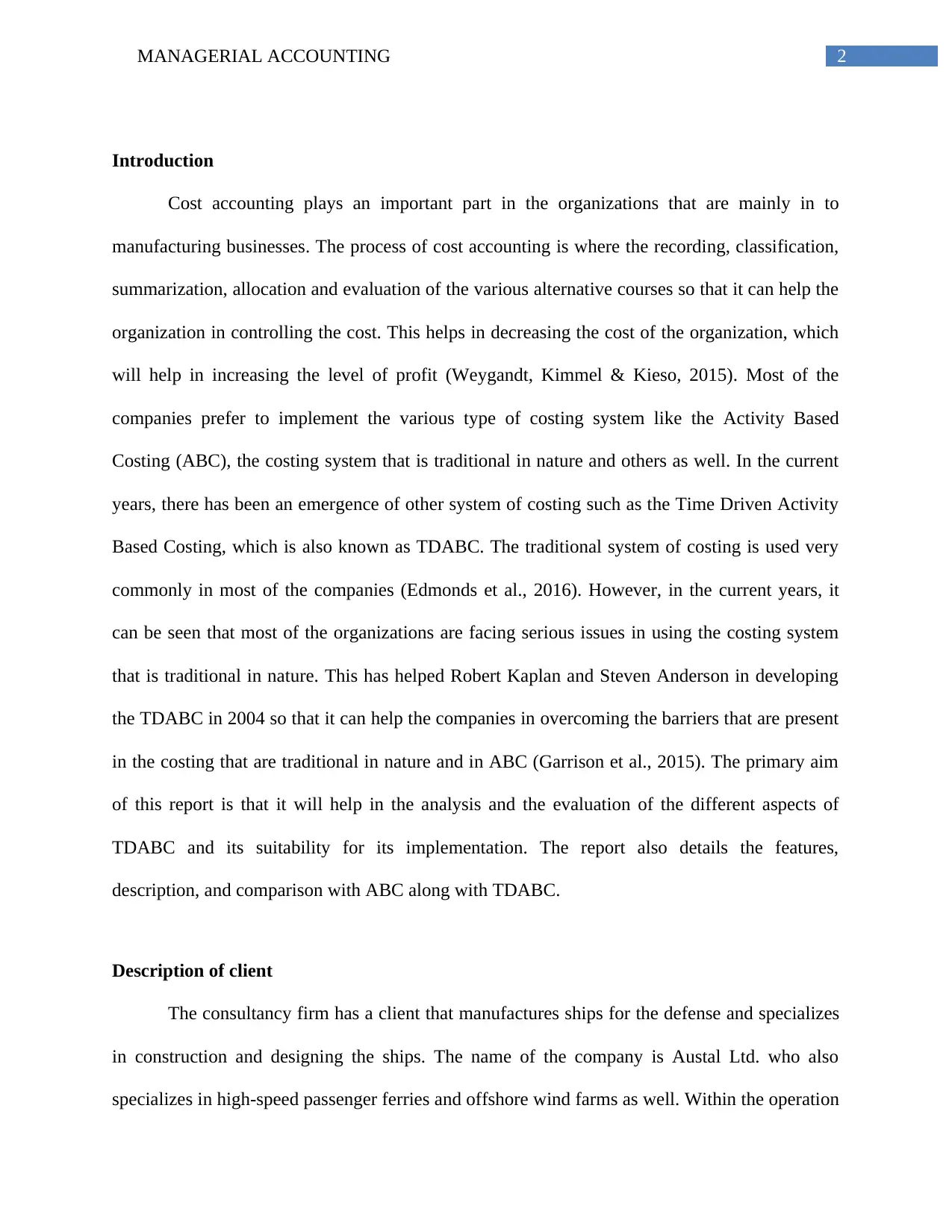
2MANAGERIAL ACCOUNTING
Introduction
Cost accounting plays an important part in the organizations that are mainly in to
manufacturing businesses. The process of cost accounting is where the recording, classification,
summarization, allocation and evaluation of the various alternative courses so that it can help the
organization in controlling the cost. This helps in decreasing the cost of the organization, which
will help in increasing the level of profit (Weygandt, Kimmel & Kieso, 2015). Most of the
companies prefer to implement the various type of costing system like the Activity Based
Costing (ABC), the costing system that is traditional in nature and others as well. In the current
years, there has been an emergence of other system of costing such as the Time Driven Activity
Based Costing, which is also known as TDABC. The traditional system of costing is used very
commonly in most of the companies (Edmonds et al., 2016). However, in the current years, it
can be seen that most of the organizations are facing serious issues in using the costing system
that is traditional in nature. This has helped Robert Kaplan and Steven Anderson in developing
the TDABC in 2004 so that it can help the companies in overcoming the barriers that are present
in the costing that are traditional in nature and in ABC (Garrison et al., 2015). The primary aim
of this report is that it will help in the analysis and the evaluation of the different aspects of
TDABC and its suitability for its implementation. The report also details the features,
description, and comparison with ABC along with TDABC.
Description of client
The consultancy firm has a client that manufactures ships for the defense and specializes
in construction and designing the ships. The name of the company is Austal Ltd. who also
specializes in high-speed passenger ferries and offshore wind farms as well. Within the operation
Introduction
Cost accounting plays an important part in the organizations that are mainly in to
manufacturing businesses. The process of cost accounting is where the recording, classification,
summarization, allocation and evaluation of the various alternative courses so that it can help the
organization in controlling the cost. This helps in decreasing the cost of the organization, which
will help in increasing the level of profit (Weygandt, Kimmel & Kieso, 2015). Most of the
companies prefer to implement the various type of costing system like the Activity Based
Costing (ABC), the costing system that is traditional in nature and others as well. In the current
years, there has been an emergence of other system of costing such as the Time Driven Activity
Based Costing, which is also known as TDABC. The traditional system of costing is used very
commonly in most of the companies (Edmonds et al., 2016). However, in the current years, it
can be seen that most of the organizations are facing serious issues in using the costing system
that is traditional in nature. This has helped Robert Kaplan and Steven Anderson in developing
the TDABC in 2004 so that it can help the companies in overcoming the barriers that are present
in the costing that are traditional in nature and in ABC (Garrison et al., 2015). The primary aim
of this report is that it will help in the analysis and the evaluation of the different aspects of
TDABC and its suitability for its implementation. The report also details the features,
description, and comparison with ABC along with TDABC.
Description of client
The consultancy firm has a client that manufactures ships for the defense and specializes
in construction and designing the ships. The name of the company is Austal Ltd. who also
specializes in high-speed passenger ferries and offshore wind farms as well. Within the operation
⊘ This is a preview!⊘
Do you want full access?
Subscribe today to unlock all pages.

Trusted by 1+ million students worldwide
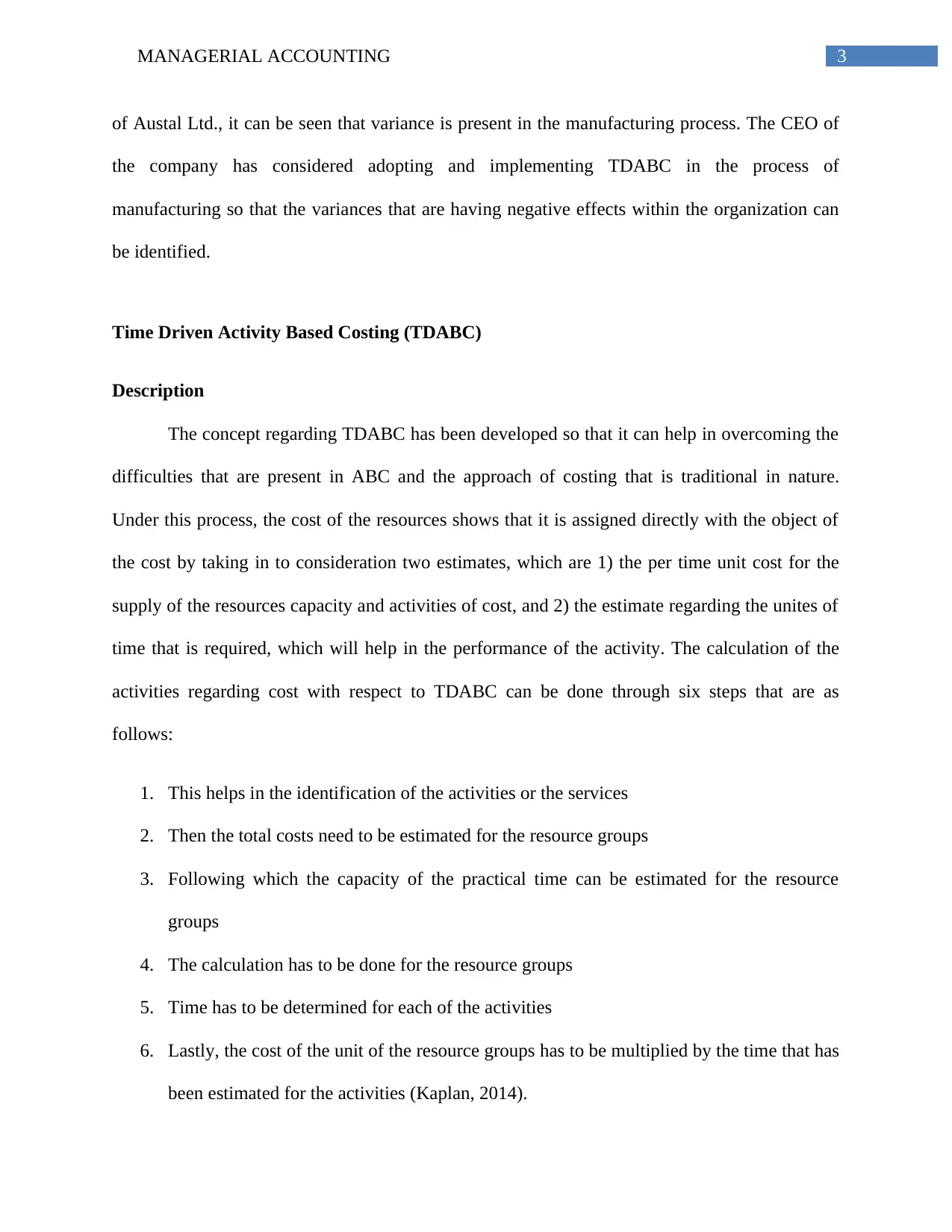
3MANAGERIAL ACCOUNTING
of Austal Ltd., it can be seen that variance is present in the manufacturing process. The CEO of
the company has considered adopting and implementing TDABC in the process of
manufacturing so that the variances that are having negative effects within the organization can
be identified.
Time Driven Activity Based Costing (TDABC)
Description
The concept regarding TDABC has been developed so that it can help in overcoming the
difficulties that are present in ABC and the approach of costing that is traditional in nature.
Under this process, the cost of the resources shows that it is assigned directly with the object of
the cost by taking in to consideration two estimates, which are 1) the per time unit cost for the
supply of the resources capacity and activities of cost, and 2) the estimate regarding the unites of
time that is required, which will help in the performance of the activity. The calculation of the
activities regarding cost with respect to TDABC can be done through six steps that are as
follows:
1. This helps in the identification of the activities or the services
2. Then the total costs need to be estimated for the resource groups
3. Following which the capacity of the practical time can be estimated for the resource
groups
4. The calculation has to be done for the resource groups
5. Time has to be determined for each of the activities
6. Lastly, the cost of the unit of the resource groups has to be multiplied by the time that has
been estimated for the activities (Kaplan, 2014).
of Austal Ltd., it can be seen that variance is present in the manufacturing process. The CEO of
the company has considered adopting and implementing TDABC in the process of
manufacturing so that the variances that are having negative effects within the organization can
be identified.
Time Driven Activity Based Costing (TDABC)
Description
The concept regarding TDABC has been developed so that it can help in overcoming the
difficulties that are present in ABC and the approach of costing that is traditional in nature.
Under this process, the cost of the resources shows that it is assigned directly with the object of
the cost by taking in to consideration two estimates, which are 1) the per time unit cost for the
supply of the resources capacity and activities of cost, and 2) the estimate regarding the unites of
time that is required, which will help in the performance of the activity. The calculation of the
activities regarding cost with respect to TDABC can be done through six steps that are as
follows:
1. This helps in the identification of the activities or the services
2. Then the total costs need to be estimated for the resource groups
3. Following which the capacity of the practical time can be estimated for the resource
groups
4. The calculation has to be done for the resource groups
5. Time has to be determined for each of the activities
6. Lastly, the cost of the unit of the resource groups has to be multiplied by the time that has
been estimated for the activities (Kaplan, 2014).
Paraphrase This Document
Need a fresh take? Get an instant paraphrase of this document with our AI Paraphraser
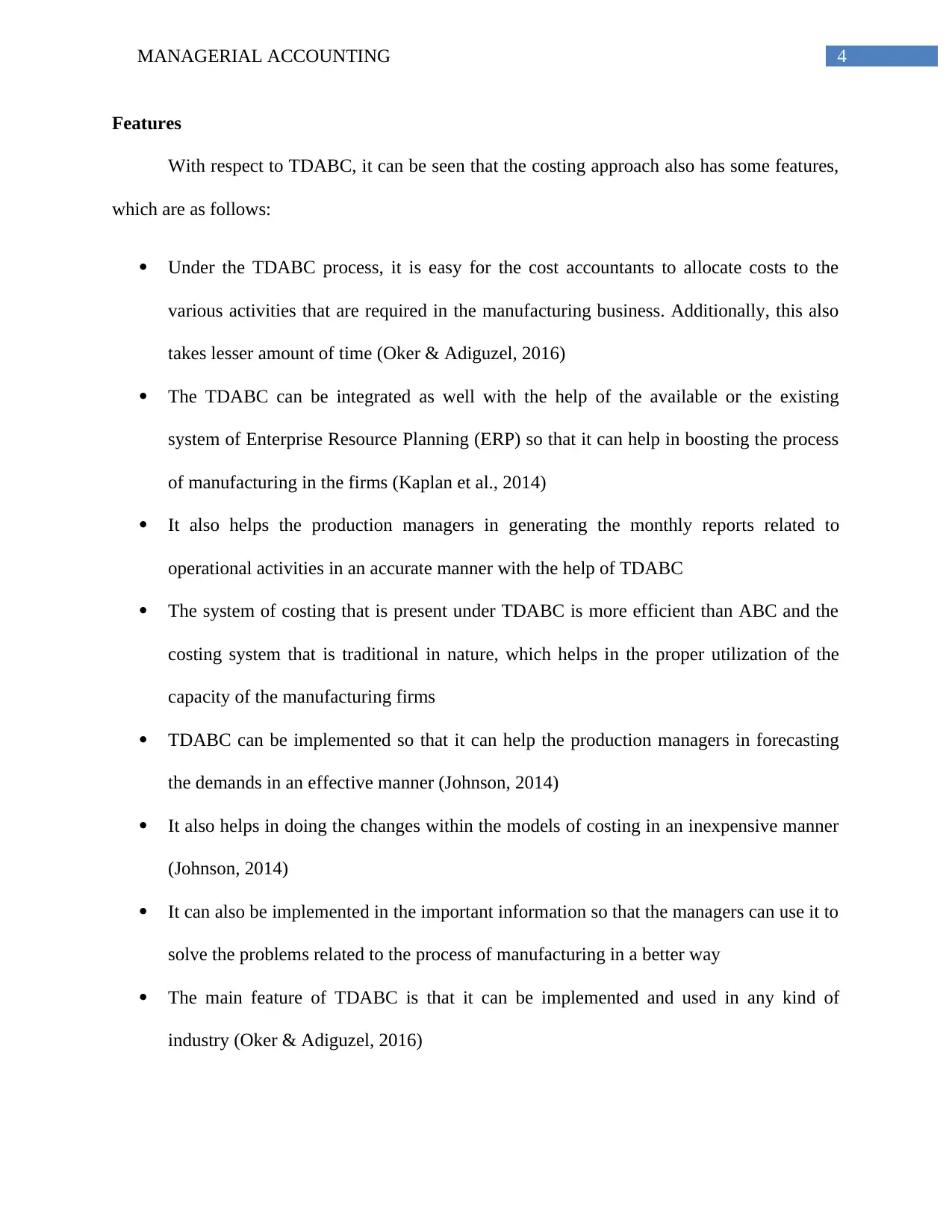
4MANAGERIAL ACCOUNTING
Features
With respect to TDABC, it can be seen that the costing approach also has some features,
which are as follows:
Under the TDABC process, it is easy for the cost accountants to allocate costs to the
various activities that are required in the manufacturing business. Additionally, this also
takes lesser amount of time (Oker & Adiguzel, 2016)
The TDABC can be integrated as well with the help of the available or the existing
system of Enterprise Resource Planning (ERP) so that it can help in boosting the process
of manufacturing in the firms (Kaplan et al., 2014)
It also helps the production managers in generating the monthly reports related to
operational activities in an accurate manner with the help of TDABC
The system of costing that is present under TDABC is more efficient than ABC and the
costing system that is traditional in nature, which helps in the proper utilization of the
capacity of the manufacturing firms
TDABC can be implemented so that it can help the production managers in forecasting
the demands in an effective manner (Johnson, 2014)
It also helps in doing the changes within the models of costing in an inexpensive manner
(Johnson, 2014)
It can also be implemented in the important information so that the managers can use it to
solve the problems related to the process of manufacturing in a better way
The main feature of TDABC is that it can be implemented and used in any kind of
industry (Oker & Adiguzel, 2016)
Features
With respect to TDABC, it can be seen that the costing approach also has some features,
which are as follows:
Under the TDABC process, it is easy for the cost accountants to allocate costs to the
various activities that are required in the manufacturing business. Additionally, this also
takes lesser amount of time (Oker & Adiguzel, 2016)
The TDABC can be integrated as well with the help of the available or the existing
system of Enterprise Resource Planning (ERP) so that it can help in boosting the process
of manufacturing in the firms (Kaplan et al., 2014)
It also helps the production managers in generating the monthly reports related to
operational activities in an accurate manner with the help of TDABC
The system of costing that is present under TDABC is more efficient than ABC and the
costing system that is traditional in nature, which helps in the proper utilization of the
capacity of the manufacturing firms
TDABC can be implemented so that it can help the production managers in forecasting
the demands in an effective manner (Johnson, 2014)
It also helps in doing the changes within the models of costing in an inexpensive manner
(Johnson, 2014)
It can also be implemented in the important information so that the managers can use it to
solve the problems related to the process of manufacturing in a better way
The main feature of TDABC is that it can be implemented and used in any kind of
industry (Oker & Adiguzel, 2016)
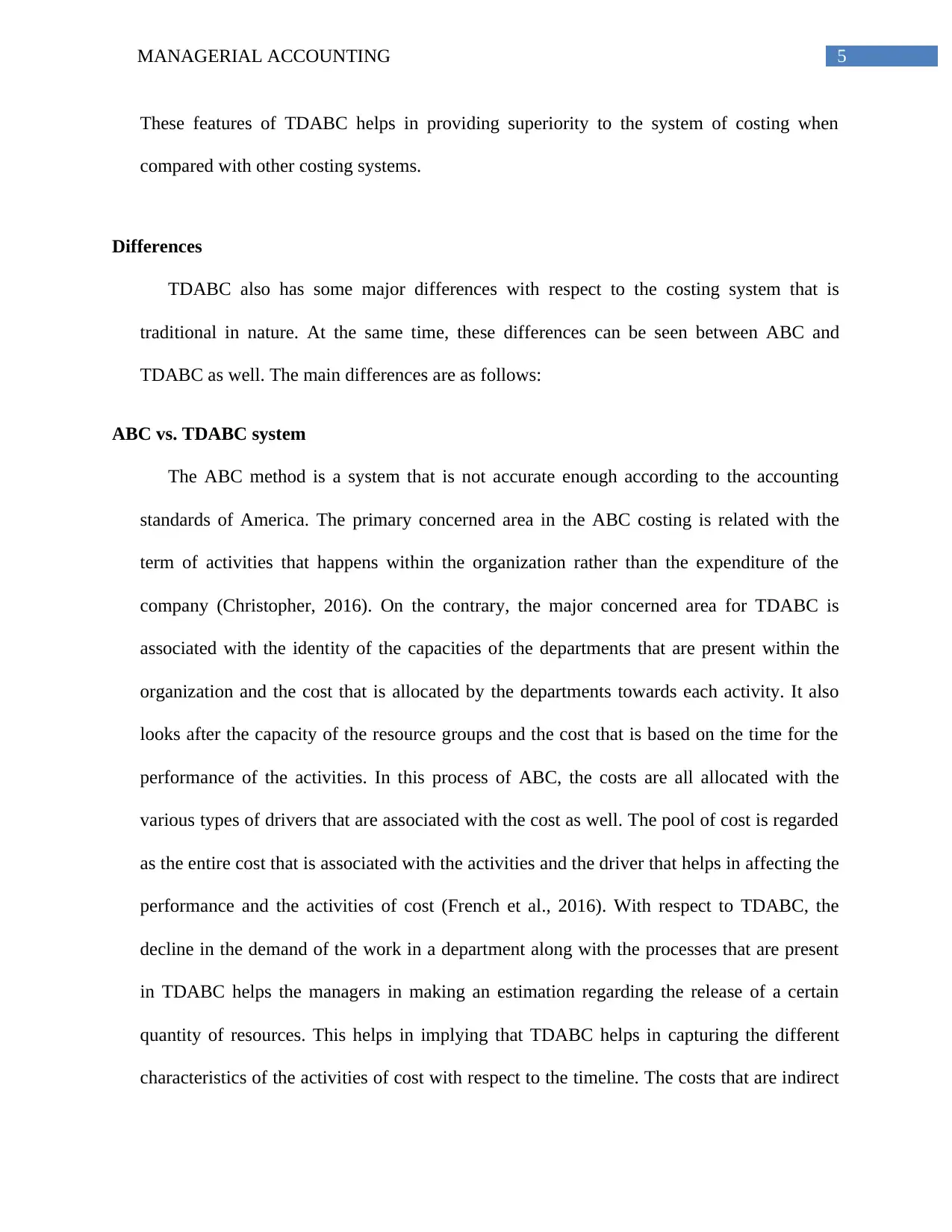
5MANAGERIAL ACCOUNTING
These features of TDABC helps in providing superiority to the system of costing when
compared with other costing systems.
Differences
TDABC also has some major differences with respect to the costing system that is
traditional in nature. At the same time, these differences can be seen between ABC and
TDABC as well. The main differences are as follows:
ABC vs. TDABC system
The ABC method is a system that is not accurate enough according to the accounting
standards of America. The primary concerned area in the ABC costing is related with the
term of activities that happens within the organization rather than the expenditure of the
company (Christopher, 2016). On the contrary, the major concerned area for TDABC is
associated with the identity of the capacities of the departments that are present within the
organization and the cost that is allocated by the departments towards each activity. It also
looks after the capacity of the resource groups and the cost that is based on the time for the
performance of the activities. In this process of ABC, the costs are all allocated with the
various types of drivers that are associated with the cost as well. The pool of cost is regarded
as the entire cost that is associated with the activities and the driver that helps in affecting the
performance and the activities of cost (French et al., 2016). With respect to TDABC, the
decline in the demand of the work in a department along with the processes that are present
in TDABC helps the managers in making an estimation regarding the release of a certain
quantity of resources. This helps in implying that TDABC helps in capturing the different
characteristics of the activities of cost with respect to the timeline. The costs that are indirect
These features of TDABC helps in providing superiority to the system of costing when
compared with other costing systems.
Differences
TDABC also has some major differences with respect to the costing system that is
traditional in nature. At the same time, these differences can be seen between ABC and
TDABC as well. The main differences are as follows:
ABC vs. TDABC system
The ABC method is a system that is not accurate enough according to the accounting
standards of America. The primary concerned area in the ABC costing is related with the
term of activities that happens within the organization rather than the expenditure of the
company (Christopher, 2016). On the contrary, the major concerned area for TDABC is
associated with the identity of the capacities of the departments that are present within the
organization and the cost that is allocated by the departments towards each activity. It also
looks after the capacity of the resource groups and the cost that is based on the time for the
performance of the activities. In this process of ABC, the costs are all allocated with the
various types of drivers that are associated with the cost as well. The pool of cost is regarded
as the entire cost that is associated with the activities and the driver that helps in affecting the
performance and the activities of cost (French et al., 2016). With respect to TDABC, the
decline in the demand of the work in a department along with the processes that are present
in TDABC helps the managers in making an estimation regarding the release of a certain
quantity of resources. This helps in implying that TDABC helps in capturing the different
characteristics of the activities of cost with respect to the timeline. The costs that are indirect
⊘ This is a preview!⊘
Do you want full access?
Subscribe today to unlock all pages.

Trusted by 1+ million students worldwide
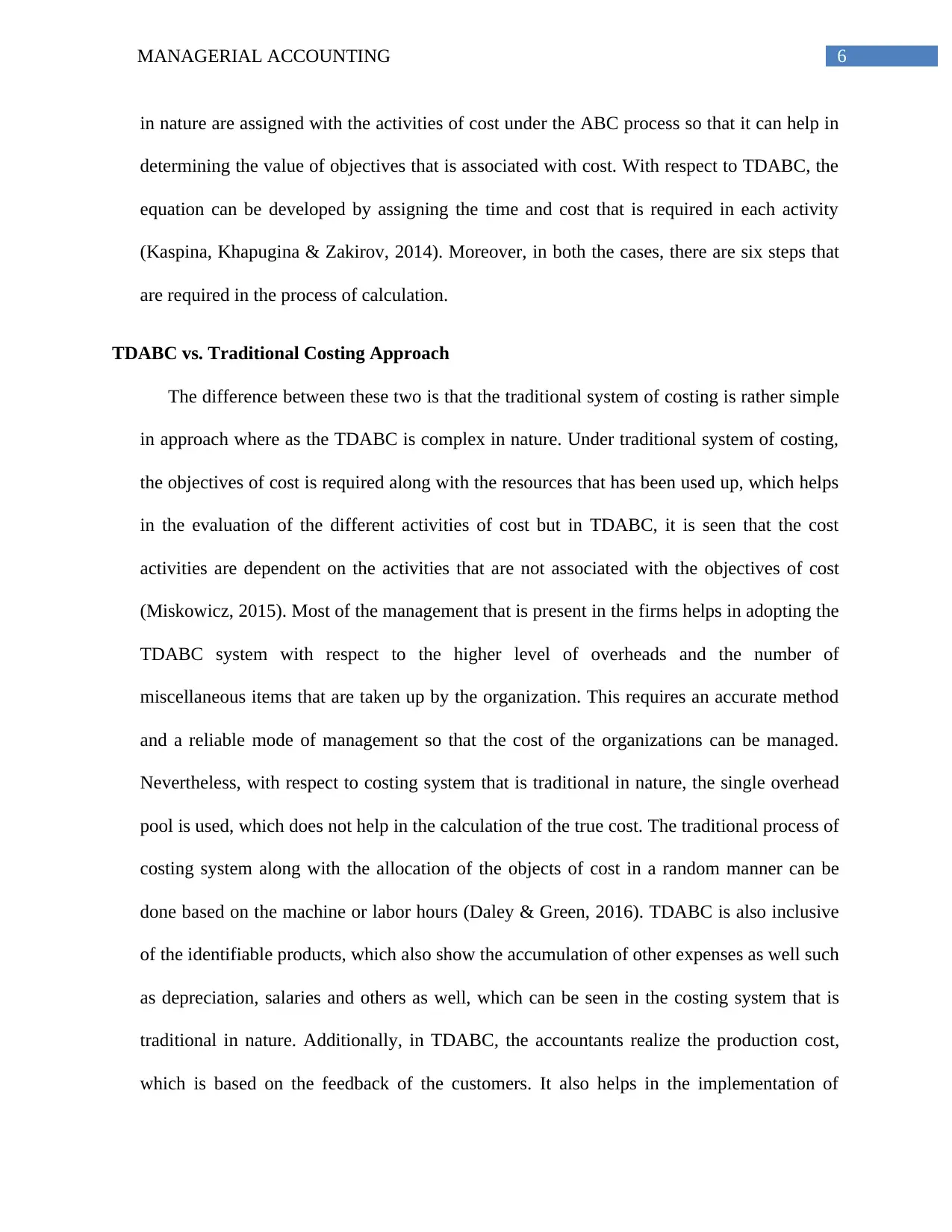
6MANAGERIAL ACCOUNTING
in nature are assigned with the activities of cost under the ABC process so that it can help in
determining the value of objectives that is associated with cost. With respect to TDABC, the
equation can be developed by assigning the time and cost that is required in each activity
(Kaspina, Khapugina & Zakirov, 2014). Moreover, in both the cases, there are six steps that
are required in the process of calculation.
TDABC vs. Traditional Costing Approach
The difference between these two is that the traditional system of costing is rather simple
in approach where as the TDABC is complex in nature. Under traditional system of costing,
the objectives of cost is required along with the resources that has been used up, which helps
in the evaluation of the different activities of cost but in TDABC, it is seen that the cost
activities are dependent on the activities that are not associated with the objectives of cost
(Miskowicz, 2015). Most of the management that is present in the firms helps in adopting the
TDABC system with respect to the higher level of overheads and the number of
miscellaneous items that are taken up by the organization. This requires an accurate method
and a reliable mode of management so that the cost of the organizations can be managed.
Nevertheless, with respect to costing system that is traditional in nature, the single overhead
pool is used, which does not help in the calculation of the true cost. The traditional process of
costing system along with the allocation of the objects of cost in a random manner can be
done based on the machine or labor hours (Daley & Green, 2016). TDABC is also inclusive
of the identifiable products, which also show the accumulation of other expenses as well such
as depreciation, salaries and others as well, which can be seen in the costing system that is
traditional in nature. Additionally, in TDABC, the accountants realize the production cost,
which is based on the feedback of the customers. It also helps in the implementation of
in nature are assigned with the activities of cost under the ABC process so that it can help in
determining the value of objectives that is associated with cost. With respect to TDABC, the
equation can be developed by assigning the time and cost that is required in each activity
(Kaspina, Khapugina & Zakirov, 2014). Moreover, in both the cases, there are six steps that
are required in the process of calculation.
TDABC vs. Traditional Costing Approach
The difference between these two is that the traditional system of costing is rather simple
in approach where as the TDABC is complex in nature. Under traditional system of costing,
the objectives of cost is required along with the resources that has been used up, which helps
in the evaluation of the different activities of cost but in TDABC, it is seen that the cost
activities are dependent on the activities that are not associated with the objectives of cost
(Miskowicz, 2015). Most of the management that is present in the firms helps in adopting the
TDABC system with respect to the higher level of overheads and the number of
miscellaneous items that are taken up by the organization. This requires an accurate method
and a reliable mode of management so that the cost of the organizations can be managed.
Nevertheless, with respect to costing system that is traditional in nature, the single overhead
pool is used, which does not help in the calculation of the true cost. The traditional process of
costing system along with the allocation of the objects of cost in a random manner can be
done based on the machine or labor hours (Daley & Green, 2016). TDABC is also inclusive
of the identifiable products, which also show the accumulation of other expenses as well such
as depreciation, salaries and others as well, which can be seen in the costing system that is
traditional in nature. Additionally, in TDABC, the accountants realize the production cost,
which is based on the feedback of the customers. It also helps in the implementation of
Paraphrase This Document
Need a fresh take? Get an instant paraphrase of this document with our AI Paraphraser
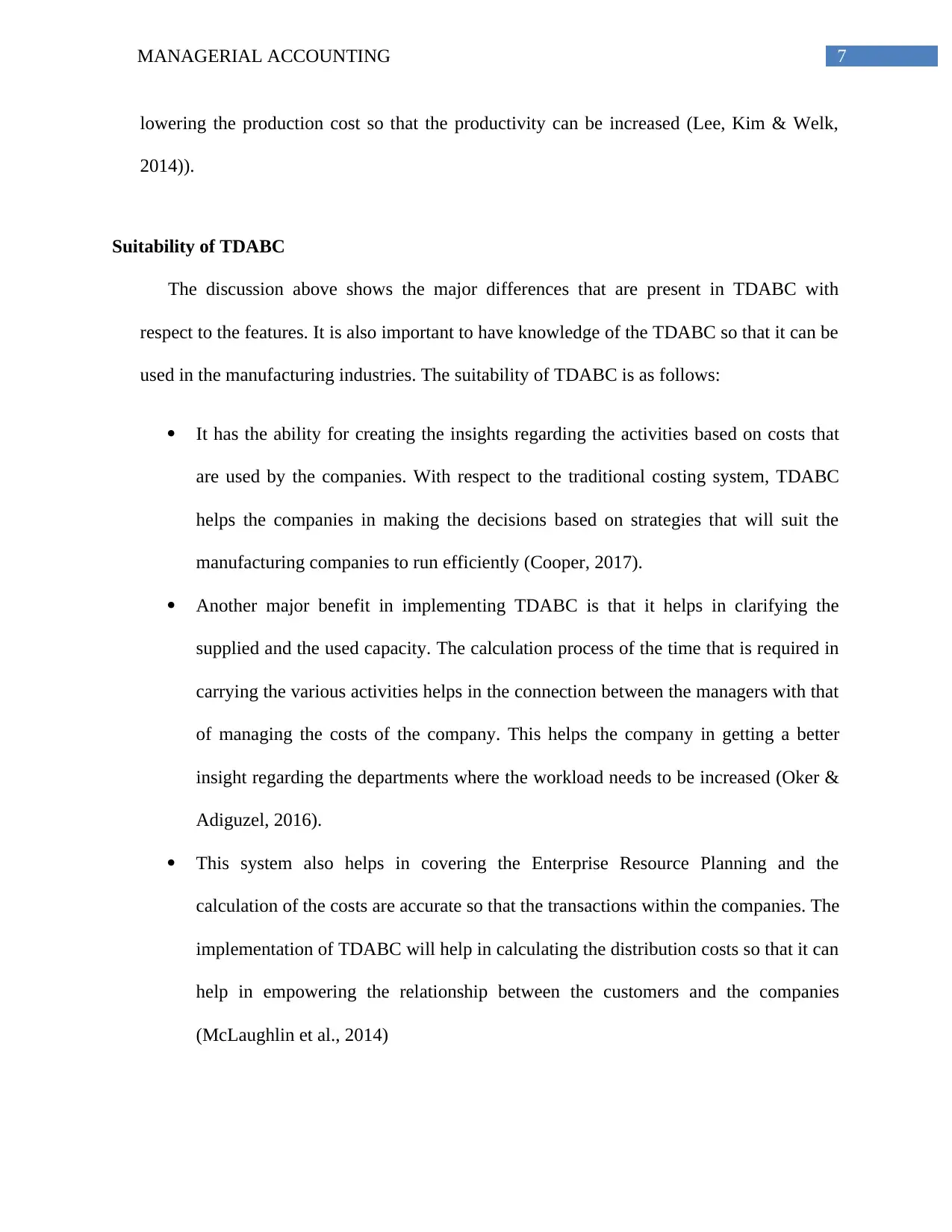
7MANAGERIAL ACCOUNTING
lowering the production cost so that the productivity can be increased (Lee, Kim & Welk,
2014)).
Suitability of TDABC
The discussion above shows the major differences that are present in TDABC with
respect to the features. It is also important to have knowledge of the TDABC so that it can be
used in the manufacturing industries. The suitability of TDABC is as follows:
It has the ability for creating the insights regarding the activities based on costs that
are used by the companies. With respect to the traditional costing system, TDABC
helps the companies in making the decisions based on strategies that will suit the
manufacturing companies to run efficiently (Cooper, 2017).
Another major benefit in implementing TDABC is that it helps in clarifying the
supplied and the used capacity. The calculation process of the time that is required in
carrying the various activities helps in the connection between the managers with that
of managing the costs of the company. This helps the company in getting a better
insight regarding the departments where the workload needs to be increased (Oker &
Adiguzel, 2016).
This system also helps in covering the Enterprise Resource Planning and the
calculation of the costs are accurate so that the transactions within the companies. The
implementation of TDABC will help in calculating the distribution costs so that it can
help in empowering the relationship between the customers and the companies
(McLaughlin et al., 2014)
lowering the production cost so that the productivity can be increased (Lee, Kim & Welk,
2014)).
Suitability of TDABC
The discussion above shows the major differences that are present in TDABC with
respect to the features. It is also important to have knowledge of the TDABC so that it can be
used in the manufacturing industries. The suitability of TDABC is as follows:
It has the ability for creating the insights regarding the activities based on costs that
are used by the companies. With respect to the traditional costing system, TDABC
helps the companies in making the decisions based on strategies that will suit the
manufacturing companies to run efficiently (Cooper, 2017).
Another major benefit in implementing TDABC is that it helps in clarifying the
supplied and the used capacity. The calculation process of the time that is required in
carrying the various activities helps in the connection between the managers with that
of managing the costs of the company. This helps the company in getting a better
insight regarding the departments where the workload needs to be increased (Oker &
Adiguzel, 2016).
This system also helps in covering the Enterprise Resource Planning and the
calculation of the costs are accurate so that the transactions within the companies. The
implementation of TDABC will help in calculating the distribution costs so that it can
help in empowering the relationship between the customers and the companies
(McLaughlin et al., 2014)
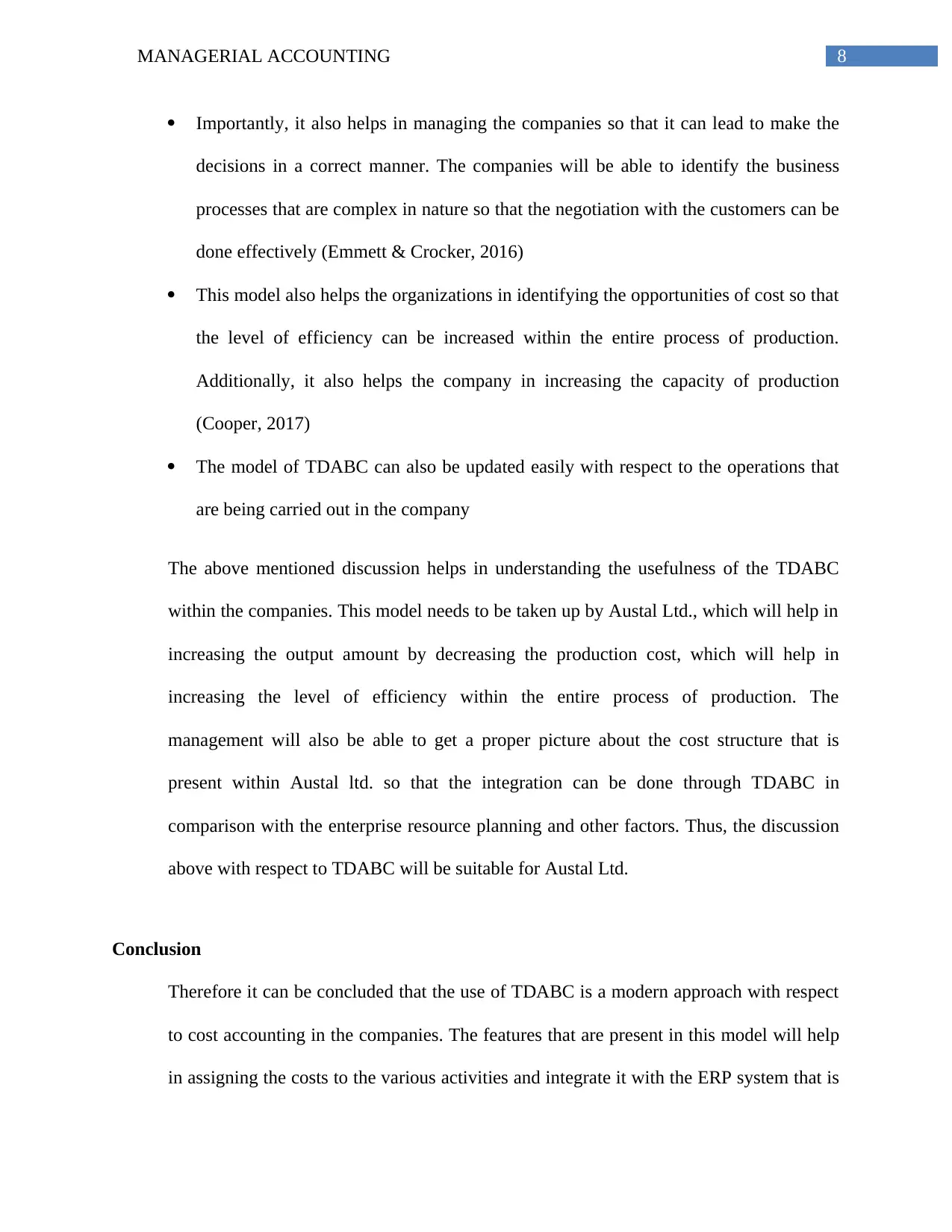
8MANAGERIAL ACCOUNTING
Importantly, it also helps in managing the companies so that it can lead to make the
decisions in a correct manner. The companies will be able to identify the business
processes that are complex in nature so that the negotiation with the customers can be
done effectively (Emmett & Crocker, 2016)
This model also helps the organizations in identifying the opportunities of cost so that
the level of efficiency can be increased within the entire process of production.
Additionally, it also helps the company in increasing the capacity of production
(Cooper, 2017)
The model of TDABC can also be updated easily with respect to the operations that
are being carried out in the company
The above mentioned discussion helps in understanding the usefulness of the TDABC
within the companies. This model needs to be taken up by Austal Ltd., which will help in
increasing the output amount by decreasing the production cost, which will help in
increasing the level of efficiency within the entire process of production. The
management will also be able to get a proper picture about the cost structure that is
present within Austal ltd. so that the integration can be done through TDABC in
comparison with the enterprise resource planning and other factors. Thus, the discussion
above with respect to TDABC will be suitable for Austal Ltd.
Conclusion
Therefore it can be concluded that the use of TDABC is a modern approach with respect
to cost accounting in the companies. The features that are present in this model will help
in assigning the costs to the various activities and integrate it with the ERP system that is
Importantly, it also helps in managing the companies so that it can lead to make the
decisions in a correct manner. The companies will be able to identify the business
processes that are complex in nature so that the negotiation with the customers can be
done effectively (Emmett & Crocker, 2016)
This model also helps the organizations in identifying the opportunities of cost so that
the level of efficiency can be increased within the entire process of production.
Additionally, it also helps the company in increasing the capacity of production
(Cooper, 2017)
The model of TDABC can also be updated easily with respect to the operations that
are being carried out in the company
The above mentioned discussion helps in understanding the usefulness of the TDABC
within the companies. This model needs to be taken up by Austal Ltd., which will help in
increasing the output amount by decreasing the production cost, which will help in
increasing the level of efficiency within the entire process of production. The
management will also be able to get a proper picture about the cost structure that is
present within Austal ltd. so that the integration can be done through TDABC in
comparison with the enterprise resource planning and other factors. Thus, the discussion
above with respect to TDABC will be suitable for Austal Ltd.
Conclusion
Therefore it can be concluded that the use of TDABC is a modern approach with respect
to cost accounting in the companies. The features that are present in this model will help
in assigning the costs to the various activities and integrate it with the ERP system that is
⊘ This is a preview!⊘
Do you want full access?
Subscribe today to unlock all pages.

Trusted by 1+ million students worldwide
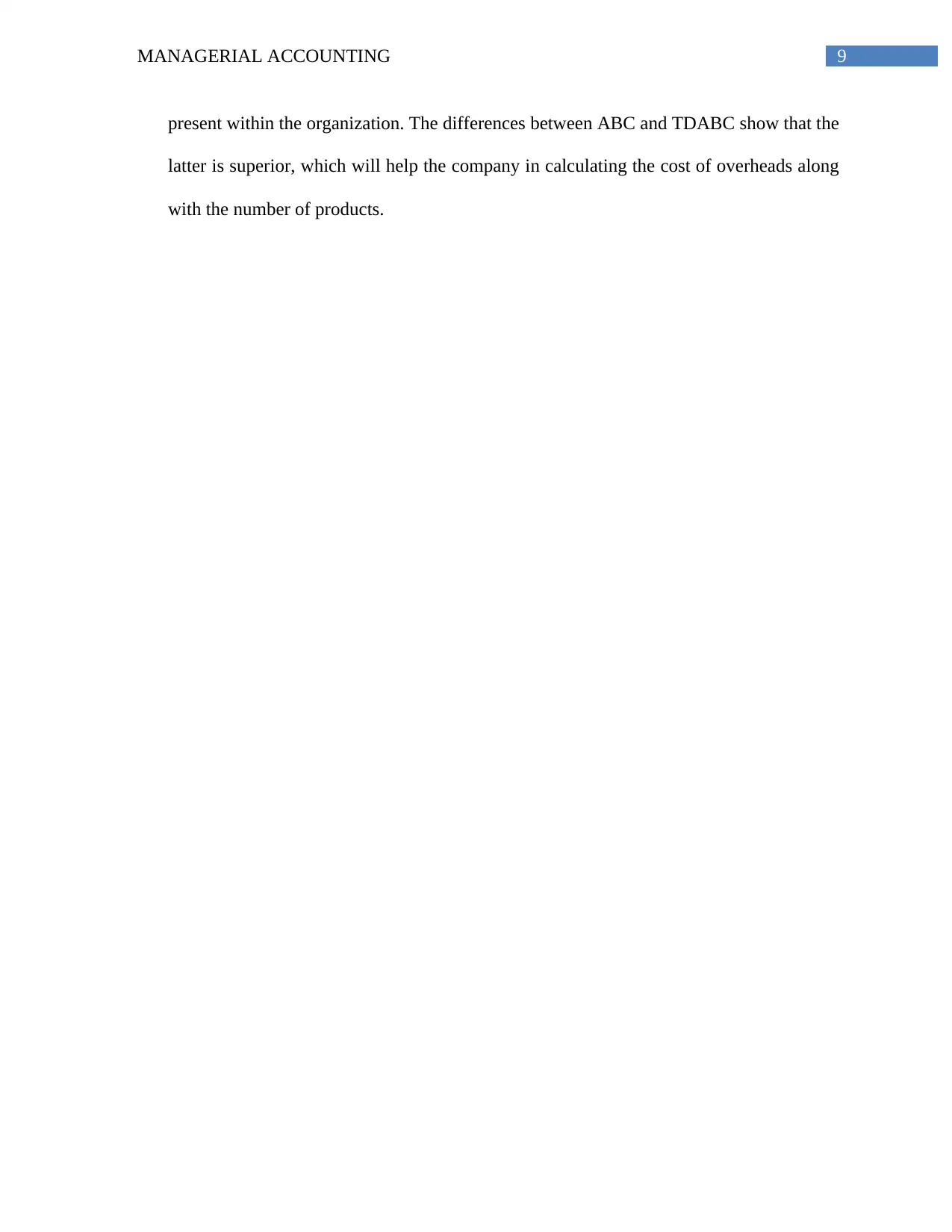
9MANAGERIAL ACCOUNTING
present within the organization. The differences between ABC and TDABC show that the
latter is superior, which will help the company in calculating the cost of overheads along
with the number of products.
present within the organization. The differences between ABC and TDABC show that the
latter is superior, which will help the company in calculating the cost of overheads along
with the number of products.
Paraphrase This Document
Need a fresh take? Get an instant paraphrase of this document with our AI Paraphraser
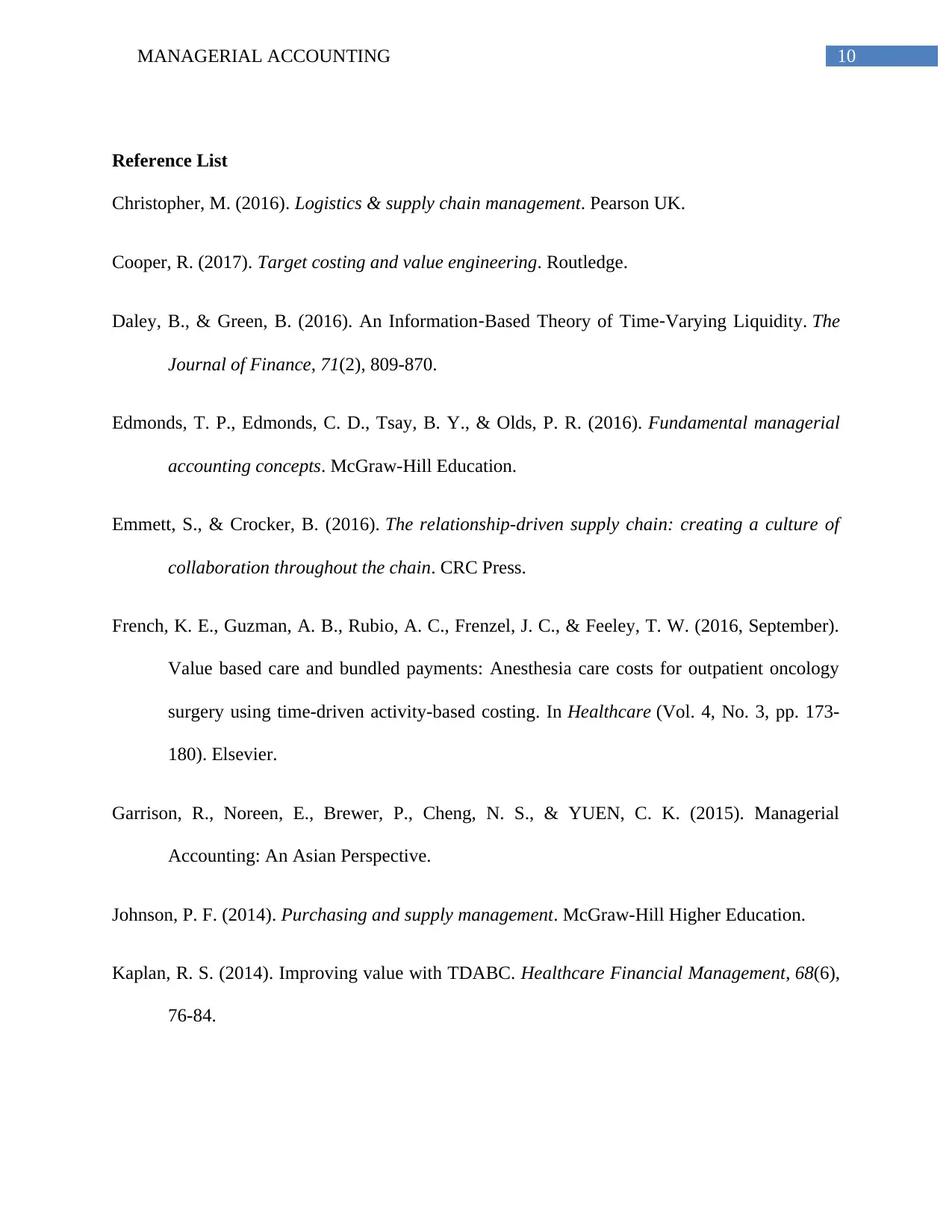
10MANAGERIAL ACCOUNTING
Reference List
Christopher, M. (2016). Logistics & supply chain management. Pearson UK.
Cooper, R. (2017). Target costing and value engineering. Routledge.
Daley, B., & Green, B. (2016). An Information‐Based Theory of Time‐Varying Liquidity. The
Journal of Finance, 71(2), 809-870.
Edmonds, T. P., Edmonds, C. D., Tsay, B. Y., & Olds, P. R. (2016). Fundamental managerial
accounting concepts. McGraw-Hill Education.
Emmett, S., & Crocker, B. (2016). The relationship-driven supply chain: creating a culture of
collaboration throughout the chain. CRC Press.
French, K. E., Guzman, A. B., Rubio, A. C., Frenzel, J. C., & Feeley, T. W. (2016, September).
Value based care and bundled payments: Anesthesia care costs for outpatient oncology
surgery using time-driven activity-based costing. In Healthcare (Vol. 4, No. 3, pp. 173-
180). Elsevier.
Garrison, R., Noreen, E., Brewer, P., Cheng, N. S., & YUEN, C. K. (2015). Managerial
Accounting: An Asian Perspective.
Johnson, P. F. (2014). Purchasing and supply management. McGraw-Hill Higher Education.
Kaplan, R. S. (2014). Improving value with TDABC. Healthcare Financial Management, 68(6),
76-84.
Reference List
Christopher, M. (2016). Logistics & supply chain management. Pearson UK.
Cooper, R. (2017). Target costing and value engineering. Routledge.
Daley, B., & Green, B. (2016). An Information‐Based Theory of Time‐Varying Liquidity. The
Journal of Finance, 71(2), 809-870.
Edmonds, T. P., Edmonds, C. D., Tsay, B. Y., & Olds, P. R. (2016). Fundamental managerial
accounting concepts. McGraw-Hill Education.
Emmett, S., & Crocker, B. (2016). The relationship-driven supply chain: creating a culture of
collaboration throughout the chain. CRC Press.
French, K. E., Guzman, A. B., Rubio, A. C., Frenzel, J. C., & Feeley, T. W. (2016, September).
Value based care and bundled payments: Anesthesia care costs for outpatient oncology
surgery using time-driven activity-based costing. In Healthcare (Vol. 4, No. 3, pp. 173-
180). Elsevier.
Garrison, R., Noreen, E., Brewer, P., Cheng, N. S., & YUEN, C. K. (2015). Managerial
Accounting: An Asian Perspective.
Johnson, P. F. (2014). Purchasing and supply management. McGraw-Hill Higher Education.
Kaplan, R. S. (2014). Improving value with TDABC. Healthcare Financial Management, 68(6),
76-84.
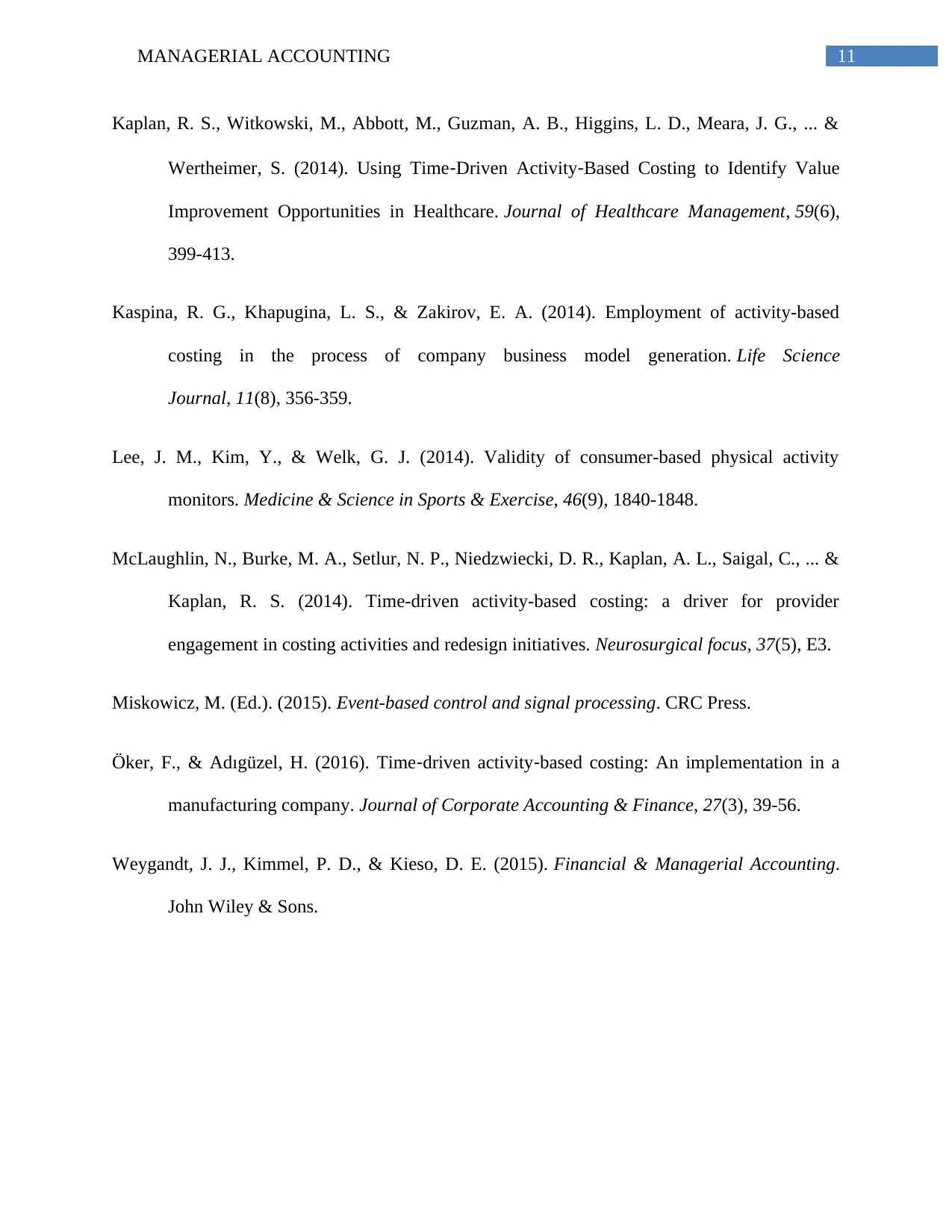
11MANAGERIAL ACCOUNTING
Kaplan, R. S., Witkowski, M., Abbott, M., Guzman, A. B., Higgins, L. D., Meara, J. G., ... &
Wertheimer, S. (2014). Using Time‐Driven Activity‐Based Costing to Identify Value
Improvement Opportunities in Healthcare. Journal of Healthcare Management, 59(6),
399-413.
Kaspina, R. G., Khapugina, L. S., & Zakirov, E. A. (2014). Employment of activity-based
costing in the process of company business model generation. Life Science
Journal, 11(8), 356-359.
Lee, J. M., Kim, Y., & Welk, G. J. (2014). Validity of consumer-based physical activity
monitors. Medicine & Science in Sports & Exercise, 46(9), 1840-1848.
McLaughlin, N., Burke, M. A., Setlur, N. P., Niedzwiecki, D. R., Kaplan, A. L., Saigal, C., ... &
Kaplan, R. S. (2014). Time-driven activity-based costing: a driver for provider
engagement in costing activities and redesign initiatives. Neurosurgical focus, 37(5), E3.
Miskowicz, M. (Ed.). (2015). Event-based control and signal processing. CRC Press.
Öker, F., & Adıgüzel, H. (2016). Time‐driven activity‐based costing: An implementation in a
manufacturing company. Journal of Corporate Accounting & Finance, 27(3), 39-56.
Weygandt, J. J., Kimmel, P. D., & Kieso, D. E. (2015). Financial & Managerial Accounting.
John Wiley & Sons.
Kaplan, R. S., Witkowski, M., Abbott, M., Guzman, A. B., Higgins, L. D., Meara, J. G., ... &
Wertheimer, S. (2014). Using Time‐Driven Activity‐Based Costing to Identify Value
Improvement Opportunities in Healthcare. Journal of Healthcare Management, 59(6),
399-413.
Kaspina, R. G., Khapugina, L. S., & Zakirov, E. A. (2014). Employment of activity-based
costing in the process of company business model generation. Life Science
Journal, 11(8), 356-359.
Lee, J. M., Kim, Y., & Welk, G. J. (2014). Validity of consumer-based physical activity
monitors. Medicine & Science in Sports & Exercise, 46(9), 1840-1848.
McLaughlin, N., Burke, M. A., Setlur, N. P., Niedzwiecki, D. R., Kaplan, A. L., Saigal, C., ... &
Kaplan, R. S. (2014). Time-driven activity-based costing: a driver for provider
engagement in costing activities and redesign initiatives. Neurosurgical focus, 37(5), E3.
Miskowicz, M. (Ed.). (2015). Event-based control and signal processing. CRC Press.
Öker, F., & Adıgüzel, H. (2016). Time‐driven activity‐based costing: An implementation in a
manufacturing company. Journal of Corporate Accounting & Finance, 27(3), 39-56.
Weygandt, J. J., Kimmel, P. D., & Kieso, D. E. (2015). Financial & Managerial Accounting.
John Wiley & Sons.
⊘ This is a preview!⊘
Do you want full access?
Subscribe today to unlock all pages.

Trusted by 1+ million students worldwide
1 out of 12
Related Documents
Your All-in-One AI-Powered Toolkit for Academic Success.
+13062052269
info@desklib.com
Available 24*7 on WhatsApp / Email
![[object Object]](/_next/static/media/star-bottom.7253800d.svg)
Unlock your academic potential
Copyright © 2020–2025 A2Z Services. All Rights Reserved. Developed and managed by ZUCOL.





